How long roof underlayment can be exposed depends on its quality, frequent weather events in your area, and your roof type. Roof underlayments are mainly classified as two types: felt and synthetic. While felt underlayment is affordable, synthetic roof underlayment is more costly but even more effective. However, regardless of the type, roof underlayment is an essential component of a roofing system. It provides additional support to roofing materials while also protecting the roof deck from moisture and the elements. If your question is how long roof underlayment can be exposed to the weather and environment, keep reading.
Types of Roof Underlayment
Roof underlayment is available in various materials, each with its advantages and disadvantages. The three main types of roof underlayment are:
- Rubberized asphalt
- Asphalt-saturated felt
- Non-bitumen synthetics
1. Rubberized Asphalt
Rubberized asphalt underlayment is a peel-and-stick material that offers excellent protection against water damage. It is more resistant to heat than asphalt-saturated felt, making it more durable and longer-lasting.
Pros
- Can be left exposed for 90 to 180 days
- Excellent protection against water damage
- Resistant to heat and UV rays
Cons
- Higher cost compared to asphalt-saturated felt
- Requires professional installation
2. Asphalt-Saturated Felt
Asphalt-saturated felt, otherwise known as tar paper or felt paper, is one of the oldest types of roof underlayment. It is made of paper saturated with crude oil byproducts. Felt paper provides moderate protection against elements and moisture from seeping into the roof deck. It is available in two thicknesses, #15 and #30, with the latter offering more water resistance. While it may not offer the same advanced features as some synthetic underlayments, asphalt-saturated felt remains popular due to its proven reliability and cost-effectiveness.
Pros
- Water-resistant, especially #30 felt
- An affordable option for low-budget projects
Cons
- Not UV resistant, must be covered immediately
- Prone to damage during installation
- Shorter lifespan compared to other types of underlayment
3. Non-Bitumen Synthetic Underlayment
Non-bitumen synthetic underlayment is a modern and advanced roofing material that offers superior performance and durability. Made from synthetic materials such as polypropylene or polyester, it provides enhanced protection against water, UV rays, and tears. With its exceptional tear resistance and superior water protection, non-bitumen synthetic underlayment is a reliable choice for those seeking a high-quality roofing solution.
Pros
- Lightweight and durable
- UV resistant
- Easier to install due to resilience and lighter weight
Cons
- Higher cost compared to asphalt-saturated felt
- Extra caution and safety measures may be required to prevent slips or accidents.

How Long Can Roof Underlayment Be Exposed?
The length of time roof underlayment can be exposed to weather elements depends on the type of underlayment, weather conditions, and how long the roof will be left uncovered. Asphalt felt is not designed to be left exposed for extended periods, as it can deteriorate quickly due to UV rays, extreme temperatures, and moisture. It should ideally be covered on the same day it is installed.
On the other hand, synthetic underlayment can withstand exposure to the elements for significantly longer periods. Most synthetic underlayment products can be left exposed for up to six months, with some offering UV resistance for up to one year. This extended exposure time makes synthetic underlayment a more suitable choice for large-scale projects or situations where the primary roofing material may be delayed.
Synthetic vs. Felt Underlayment
Both synthetic and felt underlayment offer protection for your roof, but there are notable differences between the two materials. Synthetic underlayment is more water-resistant, has a slippery surface, and has an adhesive backing, allowing for better water protection without using staples. On the other hand, felt underlayment is less expensive, but offers less protection compared to the synthetic underlayment.
Factors to Consider When Choosing Roof Underlayment
Roofing material: The type of roofing material used, such as traditional shingles or metal roofing, may influence the choice of underlayment.
Climate: Synthetic underlayment may be better suited for hot or wet climates, while heavy-duty felt may be beneficial in areas prone to windstorms and snow.
Cost: Felt underlayment is generally more affordable than synthetic underlayment, but the latter offers better protection and durability.
Top Roof Underlayment Brands
Choosing the right roof underlayment is essential for ensuring long-lasting protection for your roof. Some of the top manufacturers for roofing underlayment include:
1. GAF
GAF is one of the leading manufacturers of roofing materials, including roof underlayments. They offer a range of underlayment options, such as synthetic and asphalt-saturated felt underlayment.
2. Owens Corning
Owens Corning offers a range of underlayment solutions for various roofing applications. They provide synthetic underlayments designed to offer superior protection and durability.
3. CertainTeed
CertainTeed is another well-known brand in the roofing industry. They provide a variety of underlayment products, including synthetic and self-adhering underlayments.
4. TAMKO
TAMKO is also another manufacturer of roof underlayments known for their longevity and endurance. The company manufactures two well-known roof underlayments: felt and synthetic.
5. Epilay
Epilay is a notable brand known for its innovative underlayment solutions. They offer a range of synthetic underlayments designed to provide durability, weather resistance, and ease of installation.
The Average Cost of Roof Underlayments
The average cost of roof underlayment varies depending on the type and brand. Asphalt-saturated felt typically costs around 10 cents per square foot, while synthetic underlayment can range between 11 and 15 cents per square foot.
Roof Underlayment Installation
Proper installation of roof underlayment is crucial for ensuring maximum protection and longevity of your roofing system. Roof underlayment is necessary for a quality roofing job, and in many areas, it is required by code. Following the manufacturer’s recommendations and local building codes are essential for a successful installation.

Is Underlayment Necessary?
Yes, for many reasons, roof underlayment is considered necessary. It helps roofing materials insulate the attic properly. Moreover, it serves as a moisture barrier and backup protection when shingles, or other roofing materials fail, preventing leaks and interior damage.
Does Roof Underlayment Void Your Roofing Material Warranty?
Failing to install the recommended underlayment or using an improper underlayment may potentially void the warranty on your chosen roofing material. Manufacturers often have specific guidelines regarding the type, quality, and installation methods of underlayment that need to be followed. If you have any doubts or questions, it is recommended to consult with a roofing professional or reach out directly to the manufacturer for clarification.
The Bottom Line
Roof underlayment is an essential component of any roofing system, offering essential protection against the elements and extending the life of your roof. Understanding the different types of underlayment available, how long they can be exposed to weather, and other factors will help you make an informed decision when selecting the right underlayment for your roof. Always consult with a professional roofing contractor to ensure the proper installation and adherence to local building codes and manufacturer recommendations.
Don’t Leave Underlayment Exposed To Elements- Talk To Experts Today!
Regardless of the type of underlayment you have installed, leaving it exposed to nature and weather events degrades your roofing system.
Therefore, no matter how long your roof underlayment can remain exposed to nature, we recommend homeowners cover the underlayment with replacement roofing materials instantly. It will save you from expensive deck repairs and replacements. Whether it’s replacing a few shingles or the entire roofing system, it’s best to handle the situation as quickly as possible.
Hire trusted roofers from our company, McClellands Contracting and Roofing, and start your roof replacement project today. Call (412)-353-5660 for a consultation with one of our experts.




